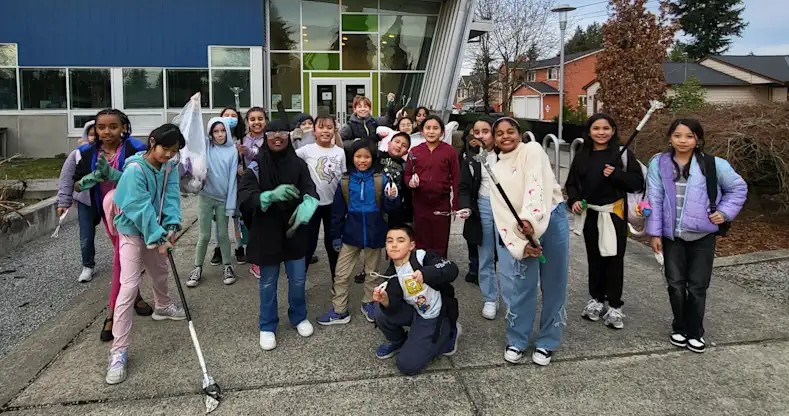Schoolyard stewardship
A green schoolyard is a multifunctional, nature-rich environment. They are designed for play, learning, exploration, and growth. Activities in gardens can encourage students to waste less food, reduce pollution and litter, and grasp how organic materials decompose and nature filters pollutants. Maintaining sustainable schoolyards and incorporating them into school activities improves health and academic performance. Green spaces also foster ecologically diverse learning environments.
Criteria for recognition
Schools
- Complete at least 1 schoolyard stewardship activity or student project with an adult advisor. Contact your program representative for project ideas.
- Conduct a baseline Waste Walk Through (WWT) at least every 2 years. Use the information to set goals.
- Share your schoolyard stewardship goals with the rest of the school. Examples could include assemblies, newsletters, announcements, or social media posts.
- Share your schoolyard stewardship efforts and progress with your program representative.
Districts
Districts can find recognition criteria for the Climate: Energy & Transportation Benchmark in the District Benchmark Guide.
Recognition form
Schools
Fill out the School Schoolyard Stewardship recognition form. You may fill out the form to receive your benchmark badge at any time of year! Contact your program representative if you need assistance filling out the form.
You can complete the recognition form over multiple sessions using the "Save" button. You will be emailed a link that allows you to continue filling out the form. Once the form is complete, select the "Submit" button.
Check out all the schools that were recognized for Schoolyard Stewardship in 2024-25.
Districts
Fill out the District Schoolyard Stewardship recognition form. Districts may fill out the form and receive the benchmark badge in the spring of each school year.
Schoolyard stewardship resources and activities
- Step-by-step guide to designing, creating and maintaining schoolyard habitats
- Guide to creating school gardens as outdoor learning spaces
- Pollinator site assessment form
- Developing a pollinator garden in western Washington
- Storm water assessment guide & rain garden set-up
- Purdue University Extension garden curriculum
- Pacific Northwest growing guide
Interested in learning more? Check out our resource list for more detailed information on this benchmark topic.
Success stories
The Green Team at Renaissance School or Art and Reasoning in Lake Washington School district was awarded a grant from Waste Not Washington to start a pollinator garden, irrigated by a rain barrel system. The students assembled the garden beds, filled them with soil, and planted seeds themselves. A parent volunteer helped to build the irrigation system, and students observed as it was put together. The students continue to maintain the garden regularly. The students also collect compost from snack time and turn it weekly. It was important to our Green Team that our pollinator garden be watered using a rain barrel system, to conserve water. The students manage the rain barrels (turning the drip on or off) depending on the weather, and sometimes supplement the gardens by hand-watering.
Students at Carnation Elementary School in Riverview School District planted a pollinator garden last year, and were able to use it this year in different classes. The 4th grade green team learned to identify weeds and our native pollinator plants in order to clean up the bed. They learned why we shouldn't clean up gardens too early in spring to allow pollinators to survive, They also planted garlic in the garden. They studied its lifecycle and learned how garlic helps keeps pests away. Once planting was done students looked for pollinators and identified five!
At McMicken Heights Elementary School in Highline School District, the Eco Kids are dedicated to making sure the school grounds stay clean and trash-free. They collected 3 garbage bags full of trash in one day in January. They noticed that some of the trash they picked up could have been recycled. They made announcements and taught other students at the school how to recycle. With the new benchmark recognition badge specifically for Schoolyard Stewardship, the Eco Kids have goals to make a pollinator garden on their school grounds and continue to clean up trash.

 Translate
Translate